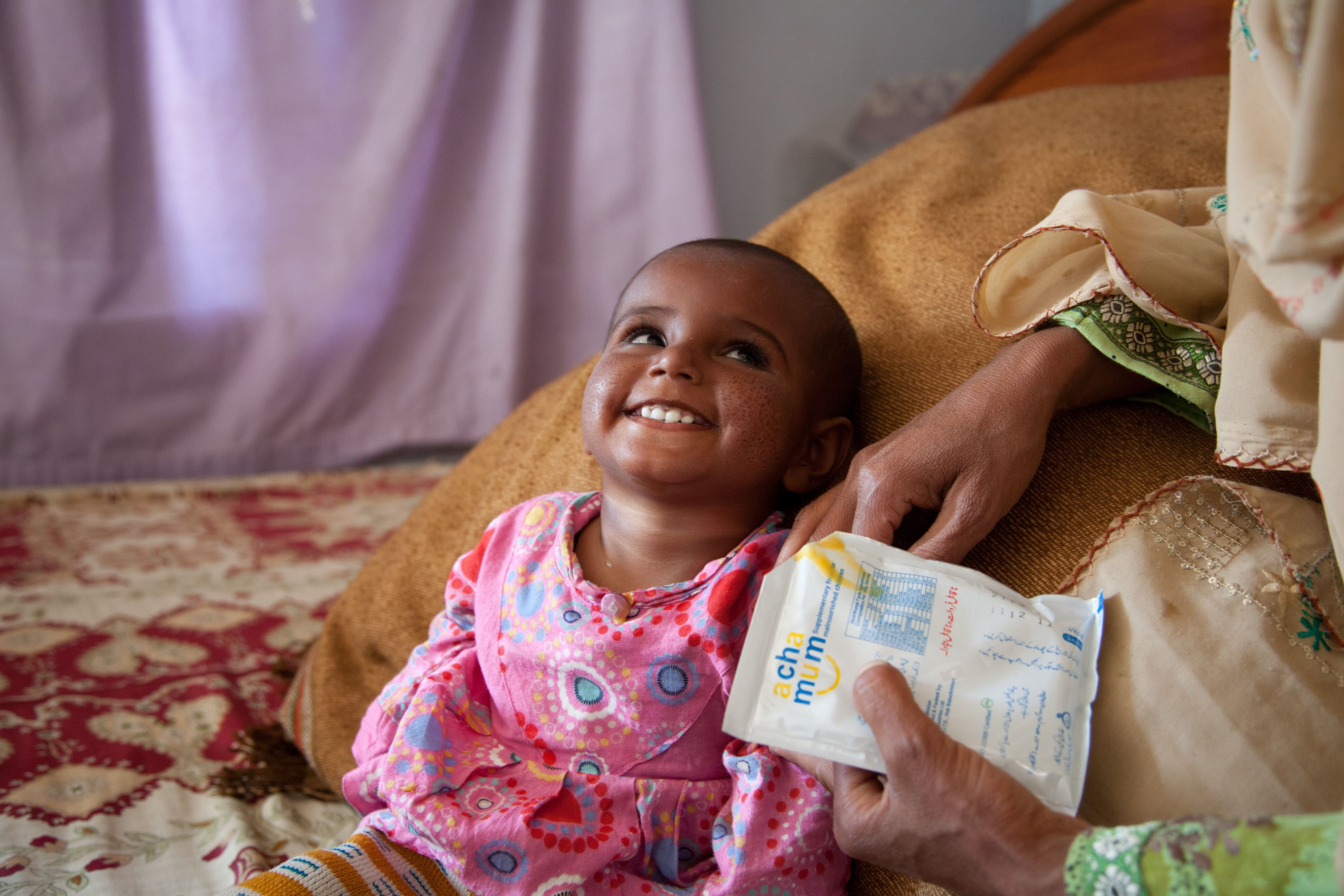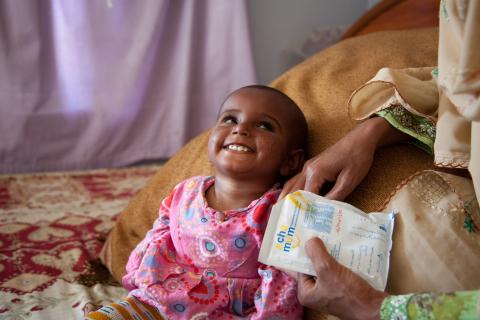Comparison of treatment of severe acute malnutrition with ready-to-use therapeutic food and ready-to-use-supplementary food: Research plans in Pakistan
By Sumra Kureishy, Meghan Callaghan-Gillespie, Gul Nawaz Khan, Atif Habib, Mica Jenkins, Khawaja Masuood Ahmed, Baseer Achakzai, Saskia de Pee, Mark Manary, Cecilia Garzon and Sajid Soofi
Sumra Kureishy is a Nutrition Officer and is currently overseeing operational research at World Food Programme in Pakistan.
Meghan Callaghan-Gillespie is a Clinical Research Implementation Coordinator in the paediatric clinical research unit at Washington University School of Medicine in St. Louis, USA.
Gul Nawaz Khan is a social scientist and public health specialist and is currently Manager of Research at the Center of Excellence in Women and Child Health at Aga Khan University.
Atif Habib is Assistant Professor of Research at the Center of Excellence in Women and Child Health at Aga Khan University.
Mica Jenkins is the Research and Evidence Officer for the Nutrition Division at World Food Programme headquarters.
Khawaja Masuood Ahmed is the National Coordinator for Nutrition and Fortification in the Ministry of National Health Services, Regulations and Coordination, Government of Pakistan.
Baseer Achakzai is Director of Nutrition, Director of the Malaria Control Programme and National Programme Manager for AIDS Control Programme in the Ministry of National Health Services, Regulations and Coordination, Government of Pakistan.
Saskia de Pee is Senior Technical Adviser for Nutrition at the World Food Programme, where she leads the Fill the Nutrient Gap team, and Adjunct Associate Professor at the Friedman School of Nutrition Science and Policy, Tufts University, Boston and at Human Nutrition, Wageningen University, the Netherlands.
Mark Manary is a paediatrician, currently appointed the Helen B. Roberson Professor of Paediatrics at Washington University School of Medicine, St. Louis, USA.
Cecilia Garzon is a senior nutritionist and currently Chief of the Education, Nutrition and Social Protection at World Food Programme Pakistan.
Sajid Soofi is a paediatrician, public health researcher and Associate Professor of Paediatrics at the Center of Excellence in Women and Child Health at Aga Khan University in Pakistan. He is the principal investigator for this trial.
World Food Programme Pakistan would like to acknowledge the collaborating partners of this trial, including the Aga Khan University and Washington University in St. Louis, as well as the donors, the Australian Government and the European Civil Protection and Humanitarian Aid Operations (ECHO). World Food Programme Pakistan would also like to thank the Government of Pakistan for its leadership, collaboration and strong commitment to improving treatment of acute malnutrition for children under five years old.
Location: Pakistan
What we know: Locally produced ready-to-use therapeutic food (RUTF) is not available in Pakistan; locally produced ready-to-use supplementary food (RUSF) is available.
What this article adds: Problems with RUTF supply chain has prompted the Government of Pakistan to commission an individual randomised, double-blind, controlled trial to compare the effectiveness of locally produced RUSF to standard RUTF to treat severe acute malnutrition (SAM) children aged 6-59 months in a community-based management of acute malnutrition programme in Umerkot district, Sindh Province. The RUSF formulation has been revised and meets RUTF specification. A sample of 850 SAM children aged 6-59 months per study arm will be selected from 10 basic health units. The treatment protocol is in line with Pakistan national guidelines. The primary outcome of interest will be recovery from SAM (mid-upper arm circumference (MUAC) ≥ 11.5cm, clinically well, and no bilateral pitting oedema for two consecutive weekly visits). Secondary outcomes are neurocognitive performance, changes in MUAC, weight and length, time to recovery from SAM, time to recovery from moderate acute malnutrition defined as MUAC ≥12.5 cm, relapse and any adverse events. Cost-effectiveness of the approach will be studied. Results will be available by second half of 2021.
Background
In Pakistan it has been estimated that approximately 15% of children under five years old are wasted, which is almost twice that of the global prevalence of 7.5% (Government of Pakistan, 2011). The Pakistan community-based management of acute malnutrition (CMAM) programme was initiated during the autumn of 2008 as an emergency response to those displaced by massive flooding in Khyber Pakhtunkhwa (KP). The programme was expanded to food-insecure and conflict-affected districts and, by 2010, approximately one third of the country was implementing the CMAM programme.
Programming is governed by Pakistan CMAM guidelines (Government of Pakistan, 2010), developed by a CMAM Technical Working Group under the nutrition wing of the Ministry of Health. CMAM is currently implemented by the Government and local non-governmental organisations in limited areas of Balochistan, Sindh, KP and Punjab, with coverage generally reported as 30-40% (Valid International, 2015; Government of Sindh, 2005). Coverage remains a challenge due to low capacity among healthcare providers and implementing partners, limited government funding allocated to CMAM, poor stakeholder coordination and supply shortages.

Supply chain challenges
Supplies of ready-to-use therapeutic food (RUTF) for SAM treatment are imported into Pakistan. Difficulties in predicting programme caseloads and delays in distribution of RUTF from the port, as well as additional costs due to taxes and duties, often lead to pipeline breaks. Given this, the Government and UNICEF initiated local production of RUTF, but this is still in progress.
To ensure a steady supply of cost-effective ready-to-use supplementary foods (RUSF) for treatment of MAM, the Government and World Food Programme (WFP) initiated local production using chickpeas as one of the main ingredients in 2010. Since then, WFP has provided technical assistance to improve RUSF production to align with new global product specifications (ISO 22000 standards) for ready-to-use lipid-based products for the treatment of MAM (RUSF) and prevention of acute malnutrition (lipid-based nutrient supplement medium quantity (LNS-MQ)) (WFP, 2016). Locally produced RUSF (Acha Mum) has been available in-country for a decade. RUTF production is being developed by the same manufacturer; however, the process is taking longer and local RUTF is not yet available.
Implementing partners have reported ad hoc use of RUSF to government-led forums to treat SAM due to non-availability and shortage of RUTF supplies. Given this, the Government requested WFP to conduct research into the efficacy of RUSF as a stop-gap or replacement for SAM treatment when RUTF is unavailable.
Proposed research
WFP, in collaboration with Aga Khan University (AKU) and Washington University in St. Louis (WUSTL), will conduct an individual, randomised, double-blind controlled clinical non-inferiority trial to compare the effectiveness of a revised formulation of Acha Mum (see Box 1) to the standard RUTF to treat uncomplicated SAM in children aged 6-59 months through the CMAM programme in Umerkot district, Sindh Province. The CMAM programme is implemented by the Pakistan Ministry of Health (MoH). Technical support and capacity-building is provided by the UN agencies responsible for their respective components (WFP – MAM, UNICEF –SAM without complications, World Health Organization (WHO) – SAM with complications).
Box 1: Profile of reformulated RUSF for SAM treatment trial
Acha Mum is a lipid-based nutrient supplement which consists of chickpeas, vegetable oils, sugar, skimmed milk powder, vitamins and minerals to meet the specifications of RUSF and LNS-MQ. Canola oil has been substituted for soybean to meet polyunsaturated fatty acids (PUFA) specifications (omega-6 (2.6-6.10g per 100g) and omega-3 (0.30-1.80g per 100g) to optimise essential fatty acids content and ratio, especially important for SAM treatment.
The skimmed milk powder content of Acha Mum is 20%, contributing to half of the total protein content. This is twice the level specified in WFP RUSF specifications and comparable to the formulation of RUTF. A detailed comparison between RUTF specifications and the revised formulation is given in Table 1.
Table 1: Nutrient composition of Acha Mum compared to the UNICEF specifications for RUTF

According to national CMAM guidelines, admission is based on MUAC criteria only and when targeted supplementary feeding (TSFP) is available, children are discharged from SAM treatment when MUAC ≥ 11.5cm (Government of Pakistan, 2010). Given this, the primary outcome of the study is recovery from SAM, defined as MUAC ≥ 11.5cm (for two consecutive weekly visits), clinically well, and no bilateral pitting oedema (for two consecutive weekly visits). The secondary outcomes are neurocognitive performance (eye-tracking measures and problem-solving) after the first four weeks of treatment; changes in MUAC, weight and length; time to recovery from SAM; time to recovery from MAM defined as MUAC ≥12.5 cm; relapse into MAM; relapse into SAM; and any adverse events. Each study arm will enrol 850 SAM children. A subset of 200 children aged 8-24 months will be selected from each study arm for the neurocognitive assessment, measuring eye-tracking and problem-solving. The assessment will be conducted at the time of diagnosis and after some weeks of therapeutic feeding.
Children with SAM (MUAC <11.5 cm and/or with bilateral pitting oedema [+, ++]) with appetite and without medical complications will receive either Acha Mum or RUTF through trained healthcare workers at the basic health units. RUTF will be procured internationally, while Acha Mum will be procured locally in Pakistan. The daily ration of RUTF and RUSF given to children in this study will be based on weight (190 kcal/kg/day).
After reaching a MUAC ≥ 11.5 cm, children will be transferred to the targeted supplementary feeding programme (TSFP), where they will be followed up every two weeks, receive Acha Mum (100g/d, as per national guidelines), and infant and young child feeding counselling (Government of Pakistan 2010). Discharge criteria from the TSFP will be: child MUAC ≥ 12.5 cm; child has not lost weight for two consecutive visits; and child has had a minimum of eight weeks of combined feeding (including the time during SAM treatment). As per the national guidelines, SAM children who have not recovered/met the exit criteria of MUAC ≥ 11.5 cm within four months are identified as “non-recovery”. Children who have had weight loss for three consecutive weeks or have not gained weight for five consecutive weeks are transferred to inpatient care (implemented by WHO). Children who have not recovered from SAM (MUAC ≥ 11.5) after three months will receive a failed treatment outcome and will be referred for further medical attention.
WFP will be responsible for procurement, labelling and distribution of RUTF and Acha Mum during the study. WFP will distribute the RUTF and Acha Mum to the AKU field office in Umerkot district, from where it will be distributed to the clinics on a weekly basis.
A cost-effectiveness assessment for each food will also be conducted, based on actual prices at the time of the study and historic prices for RUTF and Acha Mum. Costs unrelated to therapeutic food or its effectiveness (such as mother’s opportunity costs, cost of transport to the clinic and programme implementation costs) will be considered fixed and not quantified.
The study will be registered as a randomised trial in clinicaltrials.gov. Study enrolment is expected to begin in 2019. Results are expected in second half of 2021.
For more information, please contact Dr Sajid Bashir Soofi.
References
Government of Pakistan. (2010). National Guidelines for the management of acute malnutrition among children under five and pregnant and lactating women. Retrieved from www.humanitarianresponse.info/sites/www.humanitarianresponse.info/files/documents/files/Final %20CMAM%20Guidelines%20with%20NW%20inputs%20for%20printing.pdf
Government of Pakistan. (2011). National Nutrition Survey 2011. Retrieved from www.humanitarianresponse.info/en/operations/pakistan/document/national-nutrition-survey-2011
Government of Sindh. (2005). Sindh District-Based Multiple Indicators Cluster Survey 2003-04. Retrieved from http://sindhbos.gov.pk/wp-content/uploads/2014/09/Sindh-MICS-Report-2003-04.pdf
UNICEF. (2012). RUTF Product Specifications. Retrieved from www.unicef.org/supply/files/5._Common_RUTF_Specifications_and_Labelling.pdf
FP. (2016). Technical Specifications for Ready-to-Use-Supplementary-Food RUSF. Retrieved from https://documents.wfp.org/stellent/groups/public/documents/manual_guide_proced/wfp281200.pdf

